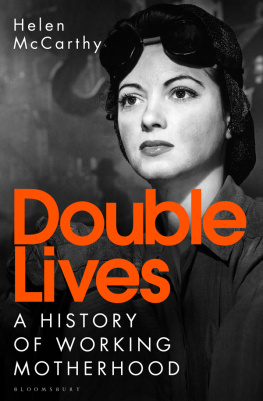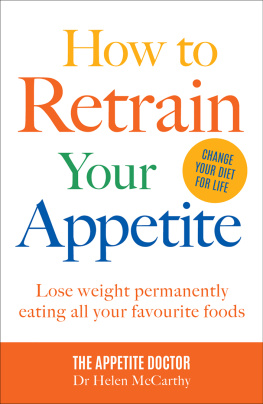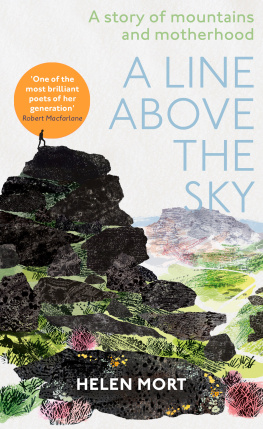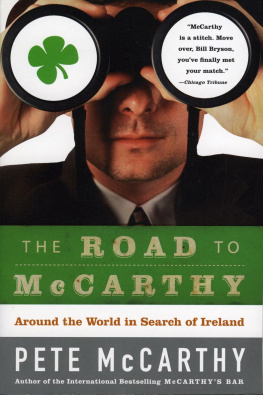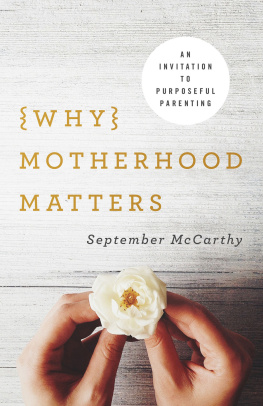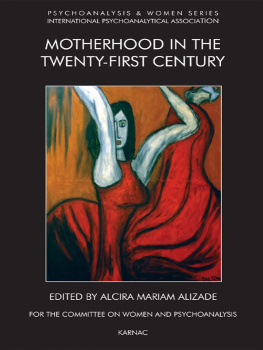Helen McCarthy - Double Lives: A History of Working Motherhood
Here you can read online Helen McCarthy - Double Lives: A History of Working Motherhood full text of the book (entire story) in english for free. Download pdf and epub, get meaning, cover and reviews about this ebook. year: 2020, publisher: Bloomsbury Publishing, genre: Home and family. Description of the work, (preface) as well as reviews are available. Best literature library LitArk.com created for fans of good reading and offers a wide selection of genres:
Romance novel
Science fiction
Adventure
Detective
Science
History
Home and family
Prose
Art
Politics
Computer
Non-fiction
Religion
Business
Children
Humor
Choose a favorite category and find really read worthwhile books. Enjoy immersion in the world of imagination, feel the emotions of the characters or learn something new for yourself, make an fascinating discovery.
- Book:Double Lives: A History of Working Motherhood
- Author:
- Publisher:Bloomsbury Publishing
- Genre:
- Year:2020
- Rating:4 / 5
- Favourites:Add to favourites
- Your mark:
- 80
- 1
- 2
- 3
- 4
- 5
Double Lives: A History of Working Motherhood: summary, description and annotation
We offer to read an annotation, description, summary or preface (depends on what the author of the book "Double Lives: A History of Working Motherhood" wrote himself). If you haven't found the necessary information about the book — write in the comments, we will try to find it.
Double Lives: A History of Working Motherhood — read online for free the complete book (whole text) full work
Below is the text of the book, divided by pages. System saving the place of the last page read, allows you to conveniently read the book "Double Lives: A History of Working Motherhood" online for free, without having to search again every time where you left off. Put a bookmark, and you can go to the page where you finished reading at any time.
Font size:
Interval:
Bookmark:

DOUBLE LIVES
By the Same Author
Women of the World: The Rise of the Female Diplomat
The British People and the League of Nations: Democracy, Citizenship and Internationalism, c. 19181945

BLOOMSBURY PUBLISHING
Bloomsbury Publishing Plc
50 Bedford Square, London, WC 1 B 3 DP , UK
BLOOMSBURY, BLOOMSBURY PUBLISHING and the Diana logo are trademarks of Bloomsbury Publishing Plc
First published in Great Britain 2020
This electronic edition published 2020
Copyright Helen McCarthy, 2020
Helen McCarthy has asserted her right under the Copyright, Designs and Patents Act, 1988, to be identified as Author of this work
All rights reserved. No part of this publication may be reproduced or transmitted in any form or by any means, electronic or mechanical, including photocopying, recording, or any information storage or retrieval system, without prior permission in writing from the publishers
: Photo by Kim Sayer / Pan Books
Material from Mass Observation is reproduced with permission of Curtis Brown Group Ltd, London on behalf of The Trustees of the Mass Observation Archive The Trustees of the Mass Observation Archive
A catalogue record for this book is available from the British Library
ISBN: HB: 978-1-4088-7073-0; TPB: 978-1-4088-7074-7; eBook: 978-1-4088-7076-1
To find out more about our authors and books visit www.bloomsbury.com and sign up for our newsletters
To whom is her first duty, herself or the coming generation? We hold, her first, second, and third duty is to herself, and, that duty being fulfilled, she will have done her duty to the coming generation.
The Freewoman , 1912
Contents
This is a book about mothers who worked for pay: what they have thought and felt and said about their lives, and what others have thought and felt and said about them over the past century and a half. It is not a universal history of women, for not all women are mothers, and not every mother works for pay. But it is, nonetheless, a story which lies at the heart of how womens everyday worlds have been shaped in modern societies like Britain.
There are no typical lives in history, but the tale of Isabella Killick, a tailoress in Mile End, east London, reveals something of the struggles experienced by poor, working-class mothers in the late nineteenth century, when our story begins. Born in the neighbouring district of Stepney in the mid-1840s, as a girl Isabella was apprenticed to the tailoring trade and continued to work for wages after her marriage to a boiler-maker named William, fitting trouser-finishing in around her household and caring duties as mother to three children. Williams health broke down in 1885, which made Isabella the familys main breadwinner, toiling at her needle from six in the morning until eight at night. Her earnings covered the rent and kept young mouths fed, but Isabellas own diet was woefully inadequate: a herring and a cup of tea was her chief living, she told a Parliamentary Committee in 1888, as for meat, I do not expect; I get meat once in six months.
Three years later, Williams condition deteriorated, prompting a temporary admission to the parish infirmary, and misfortune
Isabella Killick was one of 4 million girls and women working for wages in late Victorian They participated in the urban spectacle of the towns and cities in which the majority of Britons now lived, travelling to work on trams and trains, serving behind counters, populating office blocks, pacing hospital wards and scrubbing the floors of municipal buildings. They belonged, too, to the army of toilers cleaning and cooking in the basements and sculleries of private homes, tilling fields or slaving, like Isabella Killick, in their own modest dwellings as seamstresses, matchbox makers, childminders or washerwomen.
Many of these working women were mothers. According to the census, which forms the historians chief guide to the composition of the Victorian workforce, 13 per cent of married women were engaged in waged occupations across Britain in 1901. To this must be added the busy wives of shopkeepers, pub landlords and farmers, as well as those employed in seasonal work such as hop-picking and harvest-gathering, all of whom were likely to have gone unrecorded in the decennial population count.
And yet it was not a social norm. The dominant ideal across all classes was that of the breadwinner family: a household headed by a male worker earning a wage large enough to keep his wife and children, typically through secure, skilled work. Many men never achieved this aspiration, thwarted by low pay, unemployment The belief that fathers had a duty to provide justified mens higher wages as well as the exclusion of women from skilled trades and the restrictions on married womens employment, and it legitimised social welfare policies which assumed that all men had dependants whereas women had none. The labour market was structured so fundamentally around gender difference that only a few isolated voices saw, in the lives of wage-earning mothers, a template for womens economic independence beyond marriage and maternity. Instead, working motherhood was blamed for idleness amongst men, high infant death rates, and the evil of low-paid labour. For late Victorians, wage-earning by mothers was a warning that something had gone seriously wrong along Britains pathway to industrial modernity. The working mother stood as a symbol of domestic and economic disorder, the antithesis of progress and civilisation.
Now consider the testimony of this thirty-four-year-old secondary school teacher from a town in north-east England, written for the Mass
These reflections signal how far norms regarding mothers and paid work changed over the course of the twentieth century. By the early 2000s, women made up half of Britains workforce and the participation rate of mothers with dependent children was nearly two-thirds. and to request flexible working hours to care for dependants. Today some progressive employers go even further, offering generous parental leave schemes, subsidised childcare places, job-share opportunities and programmes to support mothers making the transition back to work. These laws, policies and initiatives seem to affirm the proposition voiced by our schoolteacher to Mass Observation: that seeking to combine the care of children with paid work has become an ordinary and legitimate aspiration for women.
Despite this shift in values, workplace equality is still elusive. The gender pay gap stands at around 14 per cent, affordable childcare is hard to find, and occupational segregation, sexual harassment and discrimination against pregnant women remain rife.for describing the wider significance that paid work might hold in these womens lives. By the end of the twentieth century, it became possible to speak about other motives and desires propelling mothers into the workplace: for personal autonomy, professional achievement, mental stimulation, friendship and sociability, or to set a good example to sons and daughters. All are now broadly accepted as legitimate reasons for why mothers might stay in or re-enter the workforce.
This is the first and major claim of this book. The meaning of working motherhood has changed dramatically over the past century and a half. What was understood to be a social problem arising from economic pressure on families has become a social norm rooted in a more expansive set of needs, rights and preferences felt and asserted by mothers. This amounts to a profound transformation in the lives of British women and this book aims to describe and account for it.
Next pageFont size:
Interval:
Bookmark:
Similar books «Double Lives: A History of Working Motherhood»
Look at similar books to Double Lives: A History of Working Motherhood. We have selected literature similar in name and meaning in the hope of providing readers with more options to find new, interesting, not yet read works.
Discussion, reviews of the book Double Lives: A History of Working Motherhood and just readers' own opinions. Leave your comments, write what you think about the work, its meaning or the main characters. Specify what exactly you liked and what you didn't like, and why you think so.

